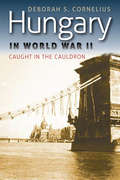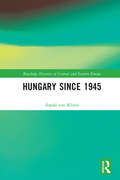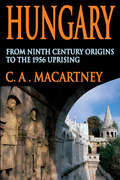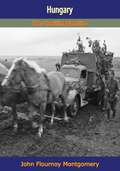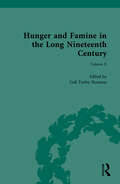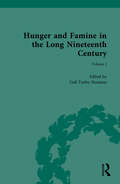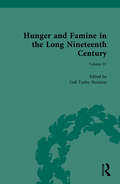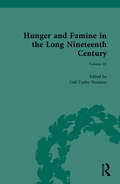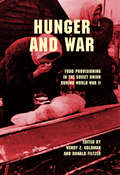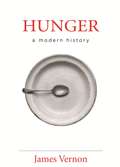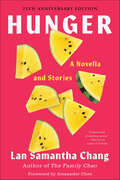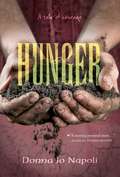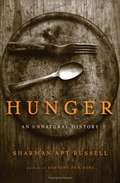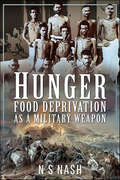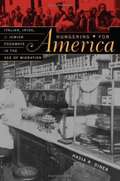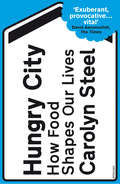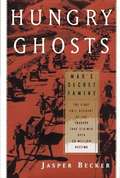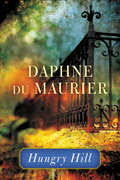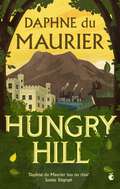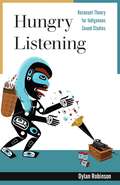- Table View
- List View
Hungary in World War II: Caught in the Cauldron (World War II: The Global, Human, and Ethical Dimension)
by Deborah S. CorneliusThe story of Hungary's participation in World War II is part of a much larger narrative—one that has never before been fully recounted for a non-Hungarian readership. As told by Deborah Cornelius, it is a fascinating tale of rise and fall, of hopes dashed and dreams in tatters. Using previously untapped sources and interviews she conducted for this book, Cornelius provides a clear account of Hungary’s attempt to regain the glory of the Hungarian Kingdom by joining forces with Nazi Germany—a decision that today seems doomed to fail from the start. For scholars and history buff s alike, Hungary in World War II is a riveting read.Cornelius begins her study with the Treaty of Trianon, which in 1920 spelled out the terms of defeat for the former kingdom. The new country of Hungary lost more than 70 percent of the kingdom’s territory, saw its population reduced by nearly the same percentage, and was stripped of five of its ten most populous cities. As Cornelius makes vividly clear, nearly all of the actions of Hungarian leaders during the succeedingdecades can be traced back to this incalculable defeat.In the early years of World War II, Hungary enjoyed boom times—and the dream of restoring the Hungarian Kingdom began to rise again. Caught in the middle as the war engulfed Europe, Hungary was drawn into an alliance with Nazi Germany. When the Germans appeared to give Hungary much of its pre–World War I territory, Hungarians began to delude themselves into believing they had won their long-sought objective. Instead, the final year of the world war brought widespread destruction and a genocidal war against Hungarian Jews. Caught between two warring behemoths, the country became a battleground for German and Soviet forces. In the wake of the war, Hungary suffered further devastation under Soviet occupation and forty-five years of communist rule.The author first became interested in Hungary in 1957 and has visited the country numerous times, beginning in the 1970s. Over the years she has talked with many Hungarians, both scholars and everyday people. Hungary in World War II draws skillfully on these personal tales to narrate events before, during, and after World War II. It provides a comprehensive and highly readable history of Hungarian participation in the war, along with an explanation of Hungarian motivation: the attempt of a defeated nation to relive its former triumphs.
Hungary since 1945 (Routledge Histories of Central and Eastern Europe)
by Árpád von KlimóLying on the political fault line between East and West for the past seventy-five years, the significance of Hungary in geopolitical terms has far outweighed the modest size of its population. This book charts the main events of these tumultuous decades including the 1956 Uprising, the end of Hungarian communism, entry into the European Union and the rise to power of Viktor Orbán and the national-conservative ruling party Fidesz.
Hungary: From Ninth Century Origins to the 1956 Uprising
by C.A. MacartneyAfter the Hungarian Revolution in November 1956, the entire world became aware of the Hungarians--the independent people who defied the might of Soviet Russia in defense of their national freedom and traditions. However, though Hungary was acknowledged for centuries as the bulwark of Europe and Christianity against the East, the lively history of the country and its people has otherwise been unfamiliar to Westerners. Written by C. A. Macartney who is long recognized as an authority in the Western world on the history of Hungary and who has been personally familiar with Hungarian problems of the past few decades, this book introduces Hungary to a Western audience.Few know that the revolution of 1956 is characteristic of many other struggles in the 1,000 years of the nation's past. Few know that the name of Hungary has been coupled with the word of freedom in many crucial moments of Western history. This unfamiliarity results partly because Hungary lies in a remote and seldom-visited quarter of Europe, but also because its language is strange and difficult, not of familiar European origin. Most of the material heretofore available on the history of Hungary has come to readers through the distorting media of foreign languages and foreign sympathies.Macartney tells the story tersely, combining a superbly readable and exciting style with meticulous scholarship, while displaying an unusual sense for narrative and acute perception into character. The book contains thirty-nine illustrations of people, places, and objects that further illuminate the text. From Arpbd, who in the ninth century led the nomad Magyars out of a desperate crisis in the east and into the Danube Basin, to the ill-fated revolution of 1956 and Janos Kadar and the "People's Republic," this is the fascinating history of a great country and a people resistant to tyranny and invasion.
Hungary: The Unwilling Satellite
by John Flournoy MontgomeryIn 1947, the former U.S. Minister to Hungary, John Flournoy Montgomery, published these heartfelt memoirs of his Budapest days during World War II. The book was, and remains, a widely read and widely quoted source for examinations of Hungarian pre-war politics, in some measure because it is unique as a thorough Western lens on interwar Hungary.
Hunger and Famine in the Long Nineteenth Century
by Gail Turley HoustonThe Hungry Forties and the Great Famine, with their horrifying monikers, deserve a section just for the many voices engaged in political, humanitarian, and social venues in juxtaposition to the voices of the starving. This volume shows how rhetoric itself experiences a crisis of representation in the face of such dramatic, tragic events: how does a culture deal with its own chosen guilty and irrational psychological motives for casting a blind eye to famine within its own borders?
Hunger and Famine in the Long Nineteenth Century
by Gail Turley HoustonCapturing Dorothy Hartley’s point that there was "a dislocation of the food supply" during the Industrial Revolution, which occurred through the enclosure movement, the poor laws, the game and corn laws (qtd. in Consuming Fictions 8), this section would begin with the date of Thomas Malthus’s "Principle of Population" (1798) to capture voices invoked during the lead up to the Reform Bill of 1832.
Hunger and Famine in the Long Nineteenth Century
by Gail Turley HoustonThis volume examines the rhetorics used around race and famine in the colonies vis-à-vis the persistence of hunger and poverty in the island nation/empire. As William Booth reminded the British in his aptly titled In Darkest England (1890), one need not look further than London’s underbelly to find intractable hunger.
Hunger and Famine in the Long Nineteenth Century
by Gail Turley HoustonThis volume examines the sub-topics on the use of the metaphor of hunger to describe the condition of women as well as to a sub-topic on invisible poverty and hunger after Chartism failed. As Disraeli noted, there were still two Englands "fed by a different food."
Hunger and War
by Donald A. Filtzer Wendy Z. GoldmanDrawing on recently released Soviet archival materials, Hunger and War investigates state food supply policy and its impact on Soviet society during World War II. It explores the role of the state in provisioning the urban population, particularly workers, with food; feeding the Red army; the medicalization of hunger; hunger in blockaded Leningrad; and civilian mortality from hunger and malnutrition in other home front industrial regions. New research reported here challenges and complicates many of the narratives and counter-narratives about the war. The authors engage such difficult subjects as starvation mortality, bitterness over privation and inequalities in provisioning, and conflicts among state organizations. At the same time, they recognize the considerable role played by the Soviet state in organizing supplies of food to adequately support the military effort and defense production and in developing policies that promoted social stability amid upheaval. The book makes a significant contribution to scholarship on the Soviet population's experience of World War II as well as to studies of war and famine.
Hunger: A Modern History
by James VernonHunger is as old as history itself. Indeed, it appears to be a timeless and inescapable biological condition. And yet perceptions of hunger and of the hungry have changed over time and differed from place to place. Hunger has a history, which can now be told. At the beginning of the nineteenth century, hunger was viewed as an unavoidable natural phenomenon or as the fault of its lazy and morally flawed victims. By the middle of the twentieth century, a new understanding of hunger had taken root. Across the British Empire and beyond, humanitarian groups, political activists, social reformers, and nutritional scientists established that the hungry were innocent victims of political and economic forces outside their control. Hunger was now seen as a global social problem requiring government intervention in the form of welfare to aid the hungry at home and abroad. James Vernon captures this momentous shift as it occurred in imperial Britain over the past two centuries. Rigorously researched, Hunger: A Modern History draws together social, cultural, and political history in a novel way, to show us how we came to have a moral, political, and social responsibility toward the hungry. Vernon forcefully reminds us how many perished from hunger in the empire and reveals how their history was intricately connected with the precarious achievements of the welfare state in Britain, as well as with the development of international institutions, such as the United Nations, committed to the conquest of world hunger. All those moved by the plight of the hungry will want to read this compelling book.
Hunger: A Novella and Stories
by Lan Samantha Chang“A masterwork of enormous power.” —Min Jin Lee, author of Pachinko The searing debut of “one of the most influential writers in American letters…Hunger is a masterpiece, a necessary haunting” (Justin Torres, author of We the Animals).A powerful exploration of the Asian American experience, Hunger weaves the forces of war and magic, food and desire, ghosts and family into poignant tales of love and loss. Celebrated author Lan Samantha Chang illuminates the lives of first-generation immigrants from China, culturally and emotionally uprooted from their homeland, who mistrust connection even as they hunger for attachment—and shows how their choices shape their children. The characters who inhabit this extraordinary collection, “a work of gorgeous, enduring prose” (Helen C. Wan, Washington Post), are caught between the burden of their past and the fragility of their unchartered future.
Hunger: A Tale of Courage
by Donna Jo NapoliThrough the eyes of twelve-year-old Lorraine this haunting novel from the award-winning author of Hidden and Hush gives insight and understanding into a little known part of history—the Irish potato famine. <P><P>It is the autumn of 1846 in Ireland. Lorraine and her brother are waiting for the time to pick the potato crop on their family farm leased from an English landowner. But this year is different—the spuds are mushy and ruined. What will Lorraine and her family do? Then Lorraine meets Miss Susannah, the daughter of the wealthy English landowner who owns Lorraine’s family’s farm, and the girls form an unlikely friendship that they must keep a secret from everyone. Two different cultures come together in a deserted Irish meadow. And Lorraine has one question: how can she help her family survive? <P><P> A little known part of history, the Irish potato famine altered history forever and caused a great immigration in the later part of the 1800s. Lorraine’s story is a heartbreaking and ultimately redemptive story of one girl’s strength and resolve to save herself and her family against all odds.
Hunger: An Unnatural History
by Sharman Apt RussellA subject as big as history and as everyday as skipping lunch -- how does hunger work? -- is explored in this thought-provoking, kaleidoscopic blend of science, anthropology, and personal reflection.
Hunger: Food Deprivation as a Military Weapon
by N. S. NashThroughout the ages, more combatants and civilians have died in war of the effects of starvation and resulting disease than have been killed by bullet or bomb. The author of this fascinating work argues that, over the last 160 years, conflicts have been decided not just on the battlefield but by the denial of an adversary’s access to food. The starvation that followed led to military indiscipline, social unrest, and a failure of governance. Numerous examples prove his point, not least Germany in 1919. The Union blockade of the Confederacy in 1861 was a major factor in the outcome of the Civil War as was the American strategy against Japan in 1943-1945. The fates of besieged forces both at Vicksburg in 1863 and the British at Kut in 1916 were sealed when control of their respective supply routes was lost. Churchill’s fears over Hitler’s U-boat campaign were well justified. ‘Logistics’ is a modern word, but it describes a fundamental element of generalship, amply demonstrated at Metz in 1870 when logistic illiteracy resulted in a vast and hitherto undefeated French army having no option but to surrender. This thought-provoking book vividly demonstrates that extreme hunger is the precursor to starvation and, consequently, almost inevitable defeat. It proves that deprivation of food is a potent weapon that no commander can ignore.
Hungering for America: Italian, Irish, and Jewish Foodways in the Age of Migration
by Hasia R. DinerMillions of immigrants were drawn to American shores, not by the mythic streets paved with gold, but rather by its tables heaped with food. How they experienced the realities of America's abundant food--its meat and white bread, its butter and cheese, fruits and vegetables, coffee and beer--reflected their earlier deprivations and shaped their ethnic practices in the new land. Hungering for America tells the stories of three distinctive groups and their unique culinary dramas. Italian immigrants transformed the food of their upper classes and of sacred days into a generic "Italian" food that inspired community pride and cohesion. Irish immigrants, in contrast, loath to mimic the foodways of the Protestant British elite, diminished food as a marker of ethnicity. And, East European Jews, who venerated food as the vital center around which family and religious practice gathered, found that dietary restrictions jarred with America's boundless choices. These tales, of immigrants in their old worlds and in the new, demonstrate the role of hunger in driving migration and the significance of food in cementing ethnic identity and community. Hasia Diner confirms the well-worn adage, "Tell me what you eat and I will tell you what you are. "
Hungering for America: Italian, Irish, and Jewish Foodways in the Age of Migration
by Hasia R. DinerMillions of immigrants were drawn to American shores, not by the mythic streets paved with gold, but rather by its tables heaped with food. How they experienced the realities of America’s abundant food—its meat and white bread, its butter and cheese, fruits and vegetables, coffee and beer—reflected their earlier deprivations and shaped their ethnic practices in the new land. Hungering for America tells the stories of three distinctive groups and their unique culinary dramas. Italian immigrants transformed the food of their upper classes and of sacred days into a generic “Italian” food that inspired community pride and cohesion. Irish immigrants, in contrast, loath to mimic the foodways of the Protestant British elite, diminished food as a marker of ethnicity. And East European Jews, who venerated food as the vital center around which family and religious practice gathered, found that dietary restrictions jarred with America’s boundless choices. These tales, of immigrants in their old worlds and in the new, demonstrate the role of hunger in driving migration and the significance of food in cementing ethnic identity and community. Hasia Diner confirms the well-worn adage, “Tell me what you eat and I will tell you what you are.”
Hungry Beat: The Scottish Independent Pop Underground Movement (1977-1984)
by Douglas MacIntyre Grant McPhee'Hungry Beat is the story of an all-too-brief era where the short-circuiting of that industry seemed viable. But hell, the times were luminous as was the music these artists made. The songs and many of the players remain, and here they tell their story and lick their wounds' Ian RankinThe immense cultural contribution made by two maverick Scottish independent music labels, Fast Product and Postcard, cannot be underestimated. Bob Last and Hilary Morrison in Edinburgh, followed by Alan Horne and Edwyn Collins in Glasgow helped to create a confidence in being Scottish that hitherto had not existed in pop music (or the arts in general in Scotland). Their fierce independent spirit stamped a mark of quality and intelligence on everything they achieved, as did their role in the emergence of regional independent labels and cultural agitators, such as Rough Trade, Factory and Zoo.Hungry Beat is a definitive oral history of these labels and the Scottish post-punk period. Covering the period 1977-1984, the book begins with the Subway Sect and the Slits performance on the White Riot tour in Edinburgh and takes us through to Bob Last shepherding the Human League from experimental electronic artists on Fast Product to their triumphant number one single in the UK and USA, Don't You Want Me. Largely built on interviews for Grant McPhee's Big Gold Dream film with Last, Hilary Morrison, Paul Morley and members of The Human League, Scars, The Mekons, Fire Engines, Josef K, Aztec Camera, The Go-Betweens and The Bluebells, Hungry Beat offers a comprehensive overview of one of the most important periods of Scottish cultural output and the two labels that changed the landscape of British music.
Hungry Beat: The Scottish Independent Pop Underground Movement (1977-1984)
by Douglas MacIntyre Grant McPhee'Hungry Beat is the story of an all-too-brief era where the short-circuiting of that industry seemed viable. But hell, the times were luminous as was the music these artists made. The songs and many of the players remain, and here they tell their story and lick their wounds' Ian RankinThe immense cultural contribution made by two maverick Scottish independent music labels, Fast Product and Postcard, cannot be underestimated. Bob Last and Hilary Morrison in Edinburgh, followed by Alan Horne and Edwyn Collins in Glasgow helped to create a confidence in being Scottish that hitherto had not existed in pop music (or the arts in general in Scotland). Their fierce independent spirit stamped a mark of quality and intelligence on everything they achieved, as did their role in the emergence of regional independent labels and cultural agitators, such as Rough Trade, Factory and Zoo.Hungry Beat is a definitive oral history of these labels and the Scottish post-punk period. Covering the period 1977-1984, the book begins with the Subway Sect and the Slits performance on the White Riot tour in Edinburgh and takes us through to Bob Last shepherding the Human League from experimental electronic artists on Fast Product to their triumphant number one single in the UK and USA, Don't You Want Me. Largely built on interviews for Grant McPhee's Big Gold Dream film with Last, Hilary Morrison, Paul Morley and members of The Human League, Scars, The Mekons, Fire Engines, Josef K, Aztec Camera, The Go-Betweens and The Bluebells, Hungry Beat offers a comprehensive overview of one of the most important periods of Scottish cultural output and the two labels that changed the landscape of British music.
Hungry City: How Food Shapes Our Lives
by Carolyn Steel'Cities cover just 2% of the world’s surface, but consume 75% of the world’s resources’.The relationship between food and cities is fundamental to our everyday lives. Food shapes cities and through them it moulds us - along with the countryside that feeds us. Yet few of us are conscious of the process and we rarely stop to wonder how food reaches our plates. Hungry City examines the way in which modern food production has damaged the balance of human existence, and reveals that we have yet to resolve a centuries-old dilemma - one which holds the key to a host of current problems, from obesity and the inexorable rise of the supermarkets, to the destruction of the natural world.Original, inspiring and written with infectious enthusiasm and belief, Hungry City illuminates an issue that is fundamental to us all.
Hungry Ghosts: Mao's Secret Famine
by Jasper BeckerIn the late 1950s and early 1960s, the Chinese people suffered the worst famine in history. This is the first full account of this dark chapter in Chinese history, which reveals state-sponsored terror, cannibalism, torture, and murder.
Hungry Hill
by Daphne Du MaurierA novel about 5 generations of a landed Irish family, the Brodericks.
Hungry Hill (Virago Modern Classics #115)
by Daphne Du MaurierFROM THE BESTSELLING AUTHOR OF REBECCA'Daphne du Maurier has no rival' SUNDAY TELEGRAPH 'du Maurier is a magician, a virtuouso' GOOD HOUSEKEEPING 'A storyteller of cunning and genius' SALLY BEAUMAN 'I tell you your mine will be in ruins and your home destroyed and your children forgotten . . . but this hill will be standing still to confound you.The Brodricks of Clonmere gain great wealth by harnessing the power of Hungry Hill and extracting the treasure it holds. The Donovans, the original owners of Clonmere Castle, resent the Brodricks' success and consider the great house and its surrounding land theirs by rights.For generations the feud between the families has simmered, always threatening to break into violence . . .
Hungry Hill (Vmc Ser. #512)
by Daphne du MaurierHungry Hill is a passionate story told with du Maurier's unique gift for drama. It follows five generations of an Irish family and the copper mine on Hungry Hill to which their fortunes and fates are so closely bound.
Hungry Listening: Resonant Theory for Indigenous Sound Studies (Indigenous Americas)
by Dylan RobinsonWInner of the Best First Book from the Native American and Indigenous Studies Association Winner of the Labriola Center American Indian National Book Award Winner of the Ann Saddlemyer Award from the Canadian Association for Theatre ResearchReimagining how we understand and write about the Indigenous listening experienceHungry Listening is the first book to consider listening from both Indigenous and settler colonial perspectives. A critical response to what has been called the &“whiteness of sound studies,&” Dylan Robinson evaluates how decolonial practices of listening emerge from increasing awareness of our listening positionality. This, he argues, involves identifying habits of settler colonial perception and contending with settler colonialism&’s &“tin ear&” that renders silent the epistemic foundations of Indigenous song as history, law, and medicine. With case studies on Indigenous participation in classical music, musicals, and popular music, Hungry Listening examines structures of inclusion that reinforce Western musical values. Alongside this inquiry on the unmarked terms of inclusion in performing arts organizations and compositional practice, Hungry Listening offers examples of &“doing sovereignty&” in Indigenous performance art, museum exhibition, and gatherings that support an Indigenous listening resurgence.Throughout the book, Robinson shows how decolonial and resurgent forms of listening might be affirmed by writing otherwise about musical experience. Through event scores, dialogic improvisation, and forms of poetic response and refusal, he demands a reorientation toward the act of reading as a way of listening. Indigenous relationships to the life of song are here sustained in writing that finds resonance in the intersubjective experience between listener, sound, and space.
Hungry Tiger: Encounters Between Hungarian and Bengali Literary Cultures
by Imarai BanghaStudy with special reference to influence of Rabindranath Tagore, 1861-1941 and his association with Hungary.
